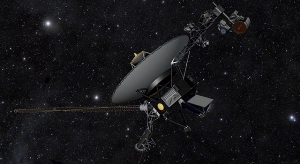Aug 17 2013
A newly published paper argues that NASA's Voyager 1 spacecraft has already entered interstellar space. The model described in the paper is new and different from other models used so far to explain the data the spacecraft has been sending back from more than 11 billion miles (18 billion kilometers) away from our sun.
 This artist's concept shows NASA's Voyager spacecraft against a field of stars in the darkness of space. The two Voyager spacecraft are traveling farther and farther away from Earth, on a journey to interstellar space, and will eventually circle around the center of the Milky Way galaxy. Image credit: NASA/JPL-Caltech
This artist's concept shows NASA's Voyager spacecraft against a field of stars in the darkness of space. The two Voyager spacecraft are traveling farther and farther away from Earth, on a journey to interstellar space, and will eventually circle around the center of the Milky Way galaxy. Image credit: NASA/JPL-Caltech
NASA's Voyager project scientist, Ed Stone of the California Institute of Technology in Pasadena, explains:
"Details of a new model have just been published that lead the scientists who created the model to argue that NASA's Voyager 1 spacecraft data can be consistent with entering interstellar space in 2012. In describing on a fine scale how magnetic field lines from the sun and magnetic field lines from interstellar space can connect to each other, they conclude Voyager 1 has been detecting the interstellar magnetic field since July 27, 2012. Their model would mean that the interstellar magnetic field direction is the same as that which originates from our sun.
Other models envision the interstellar magnetic field draped around our solar bubble and predict that the direction of the interstellar magnetic field is different from the solar magnetic field inside. By that interpretation, Voyager 1 would still be inside our solar bubble.
The fine-scale magnetic connection model will become part of the discussion among scientists as they try to reconcile what may be happening on a fine scale with what happens on a larger scale.
The Voyager 1 spacecraft is exploring a region no spacecraft has ever been to before. We will continue to look for any further developments over the coming months and years as Voyager explores an uncharted frontier."
The Voyager spacecraft were built and continue to be operated by NASA's Jet Propulsion Laboratory, in Pasadena, Calif. Caltech manages JPL for NASA. The Voyager missions are a part of NASA's Heliophysics System Observatory, sponsored by the Heliophysics Division of the Science Mission Directorate at NASA Headquarters in Washington.
For more information about Voyager, visit: http://www.nasa.gov/voyager and http://voyager.jpl.nasa.gov .